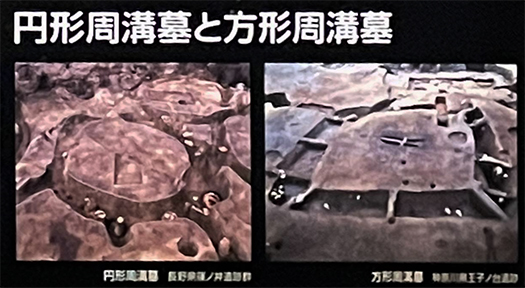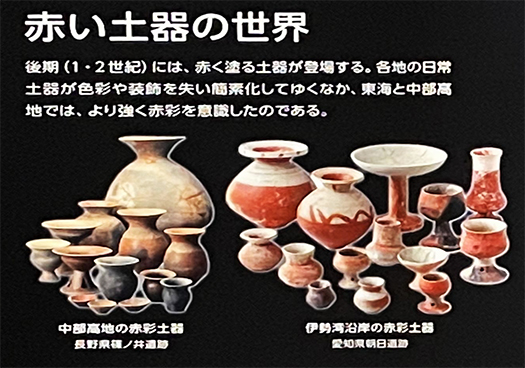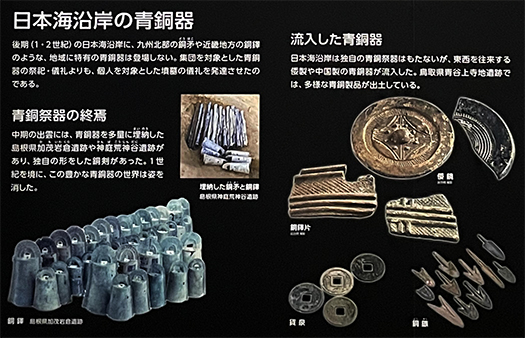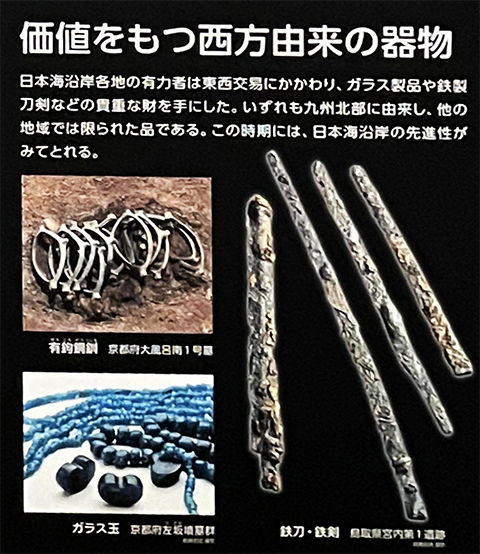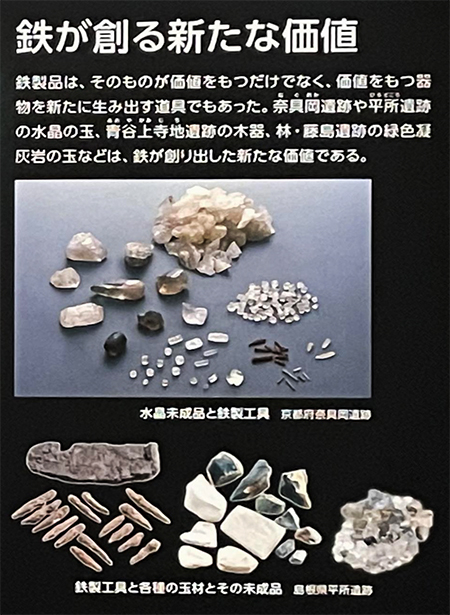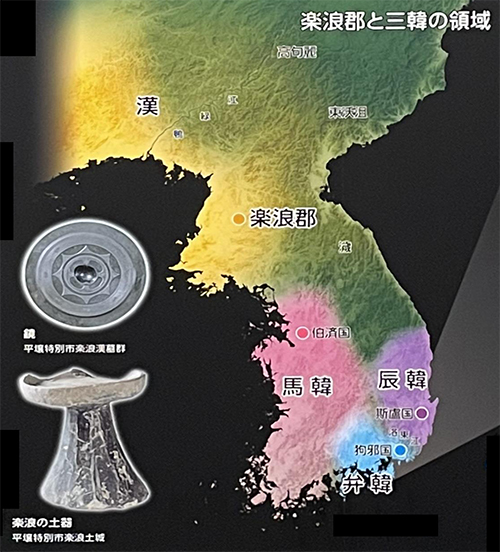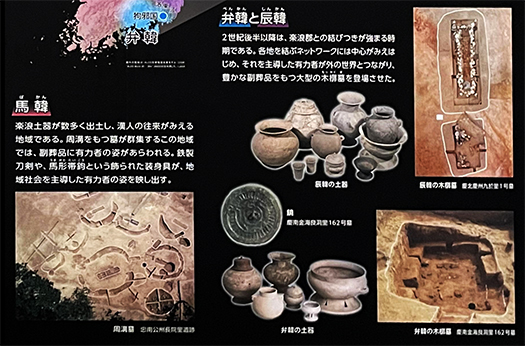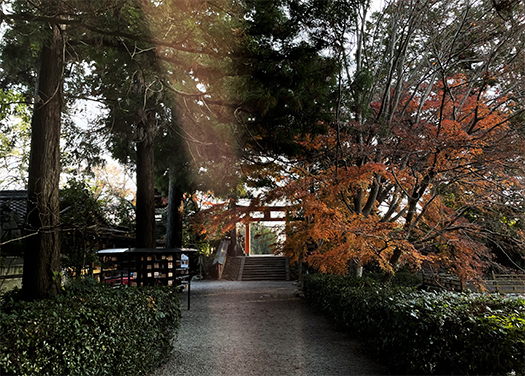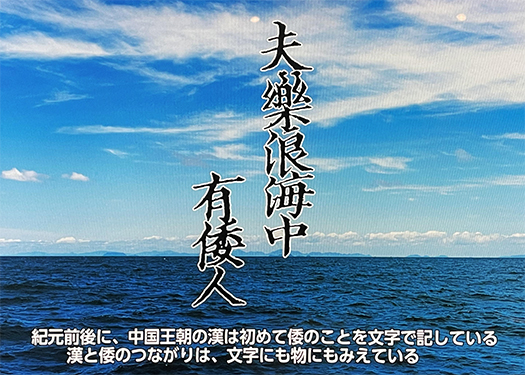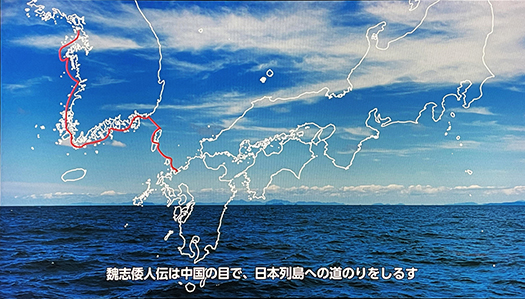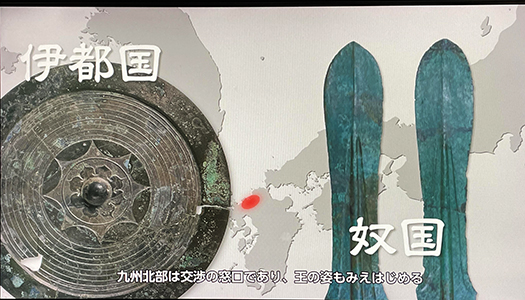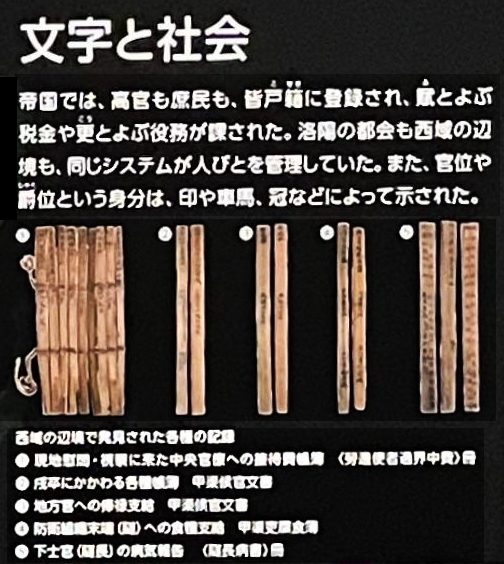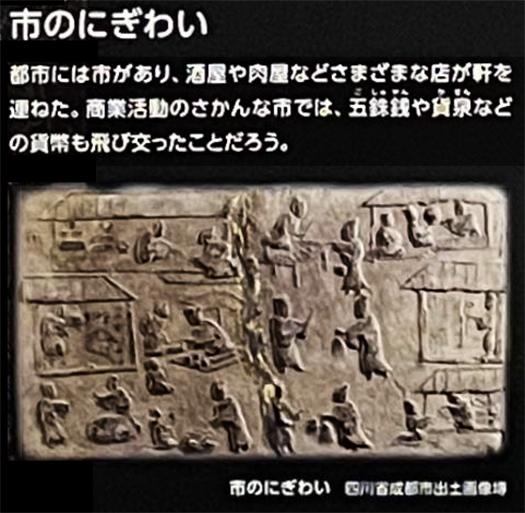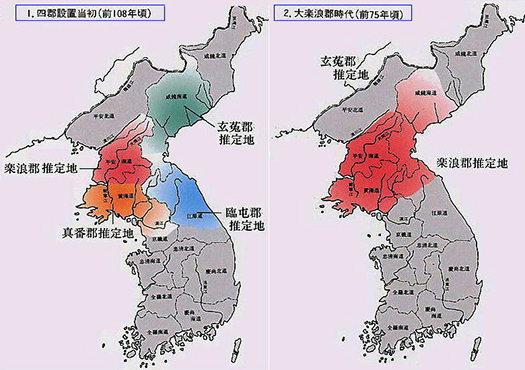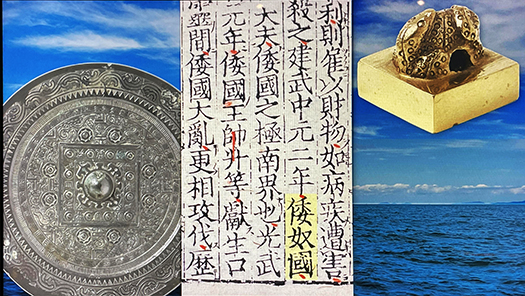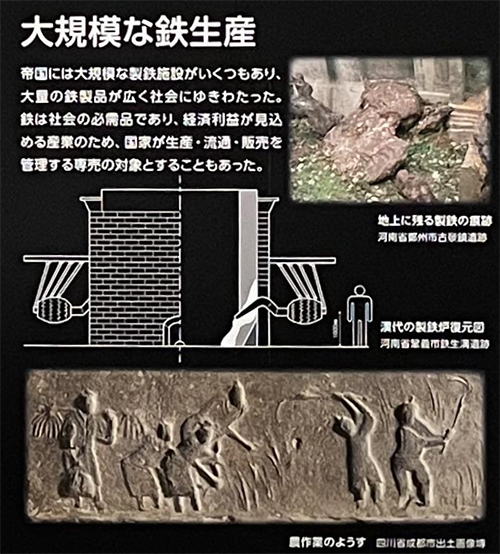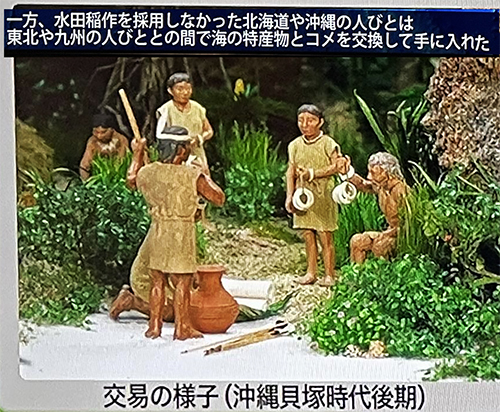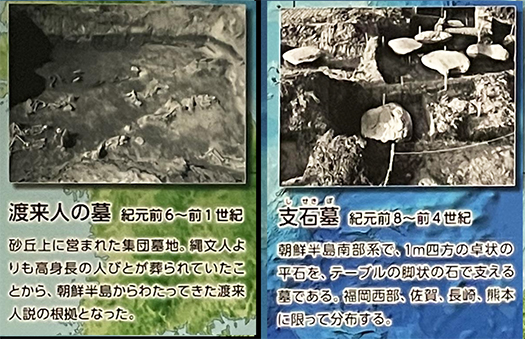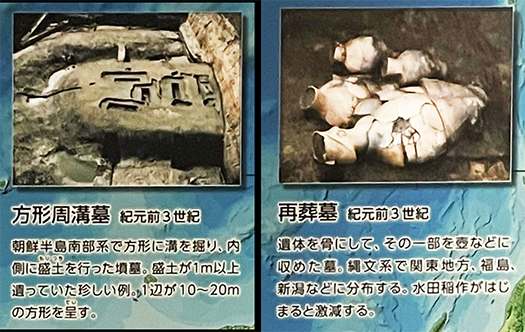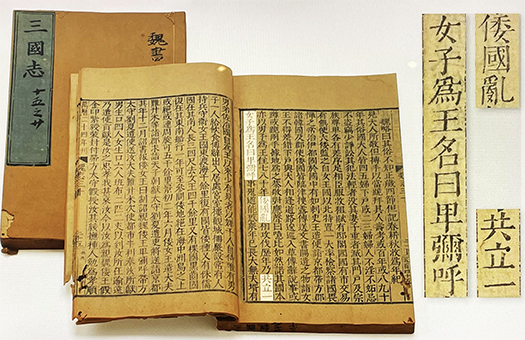
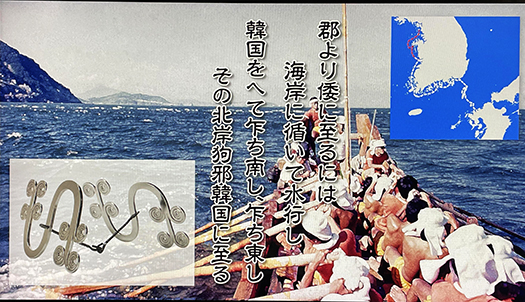

国立歴史民俗博物館の展示再構成に目を見張らされてのブログシリーズですが、
古代史探究の最大のナゾ、魏志倭人伝についてはごく控えめ。
というか、動画的なスライド映像で写真のような紹介。
考古的な実証資料がないポイントなので、扱いようがなかったのでしょう。
わたしもそういった姿勢には同感できます。
むしろ奈良平野地域に王権が成立していった「過程」がどうだったのか、
こっちの方がはるかに実証的な痕跡が残っているのだと思います。
その上で推論を。魏志倭人伝の記述は『三国志』の一節で、
西晋の陳寿により西暦280年から297年に書かれたものというのが事実。
倭国についての訪問記録や口説などに基づいて記載されたとされている。
著者である陳寿が直接倭国を訪問したという事実はなさそうです。
なので、記載された内容の一々の証拠固めはされていないと考えるべき。
3世紀中期当時の日本の伝聞情報としてとらえるべきでしょう。
ひとつの理解コンパスとして、神武東征の年代を特定していくと
そこを起点として多くのことが推論可能かもしれない。
崇神天皇は10代天皇で奈良県の纏向に王宮を営んだことが確実視されている。
この崇神帝の在位推定年代(諸説あるけれど一説に西暦266-283年)が
この魏志倭人伝の記述対象年代に近似していると思われる。
当時の倭国について著者である陳寿が情報収集した年代にほぼ当たる。
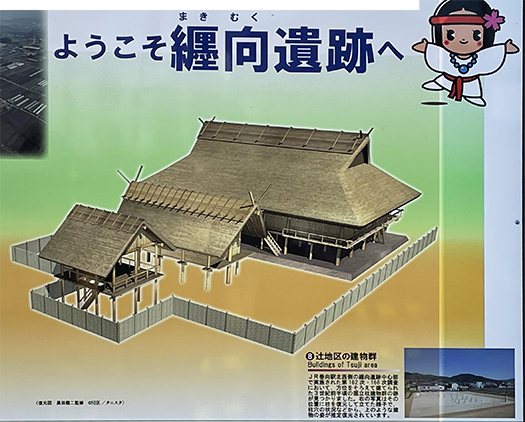
纏向遺跡の所在地である現桜井市としては埋蔵文化財センターや、
「纏向学」研究センターなどを設置し「卑弥呼の里・国のはじまりの地」という
地域自治体を挙げての取り組み・研究を推進してきている。
わたしの過去ブログでも触れていまして、かねてから注目してきています。
3世紀の日本列島における中心的な祭政中心地があったとされている。
三輪山のふもとに位置して大神神社も市域。
一説で「卑弥呼の墳墓」といわれる最初期の前方後円墳「箸墓古墳」も近接。
想像イラスト(NHK番組での復元のようです)でわかるように
崇神帝が祭政の場としたと想像される建造物痕跡も発掘されている。
この建築群は居館というよりもアマテラス神と同居して
祭政一致の拠点としていた、とされているようです。
その後、崇神帝としては祭政の分離を意図し祭祀中心施設については後代、
伊勢に遷座させていったと言われている。
現地に行って見て、箸墓古墳・三輪山との地理的な連関性を考えると
この桜井市の取り組みには高い蓋然性があると思われるところ。
この時代以降、近隣の飛鳥に王宮が営まれ石舞台古墳などが多数造営される。
東アジア世界との外交的交流の推移なども考え合わせていくと
纏向が魏志倭人伝の伝える倭国の中心地域であった可能性が高いと思えます。
そう読み返してみると、魏志倭人伝がさらに身近に見えてくる・・・。
English version⬇
The Legend of Himiko, Wei-Shi-Wa-jin-Den: The 37,000-Year History of the Japanese Archipelago – 44
Approximation of the Mimukai site in Nara and the center of Japan in the Biographies of Wei and Himiko. Positive efforts in the local city of Sakurai. The probability seems high. …
This is a blog series in response to the National Museum of Japanese History’s eye-opening reorganization of its exhibits.
The biggest riddle in the exploration of ancient history, the biography of Wei Wei, is very modest.
Rather, it is introduced like a photograph with animated slide images.
I guess they had no way to deal with this point since there is no archaeological evidence for it.
I agree with such an attitude.
I would rather discuss the “process” of the establishment of kingship in the Nara Plain area.
I think there are much more empirical traces in this area.
I would like to make an inference based on this. The description of the Wei Shih Wahnamen is from a passage in the “Records of the Three Kingdoms”.
The fact is that it was written by Chen Shou of the Western Jin Dynasty between 280 and 297 AD.
It is believed that the description was based on records of visits and oral accounts of the Japanese.
It does not seem to be true that the author, Chen Jue, visited Japan directly.
Therefore, it should be considered that the evidence for each and every one of the contents described has not been solidified.
It should be taken as hearsay information from Japan at the time of the mid-3rd century.
As one compass of understanding, if we identify the date of the Jinmu East Conquest
Many things may be deduced from that as a starting point.
It is certain that Emperor Sojin was the 10th emperor and built a royal palace in Mimamukai, Nara Prefecture.
The estimated date of reign of this Emperor Sojin (there are various theories, but one theory is that he reigned from 266 to 283 A.D.) is
The author of this book, “Wei-Shi-Wa-jin-Den,” is a Japanese writer who wrote about the Japanese nation at that time.
This is about the time when the author, Chen Shou, collected information on the Japanese state at that time.
The current city of Sakurai, the location of the Miamukai site, has established a center for buried cultural properties and a research center for “Miamukai studies.
The city of Sakurai, where the site is located, has established a Center for Buried Cultural Properties and a research center for “Miamukai Studies.
The city of Sakurai, where the site is located, has established a center for buried cultural properties and a research center for “MATSUMAKI studies,” and has been promoting local government-wide efforts and research to make the area “Himiko’s village, the place where the nation began.
I have mentioned this in my past blogs and have been paying attention to it for a long time.
It is said that there was a central ritual center in the Japanese archipelago in the 3rd century.
Located at the foot of Mt. Miwa, the city is also home to the Ogami Shrine.
Chopstick Tomb Tumulus, the earliest forward-rear circular tomb, which is said to be “Himiko’s Tomb,” is also located nearby.
As you can see in the illustration (which seems to be a reconstruction from an NHK program)
As you can see in the imaginary illustration (which seems to be a reconstruction of the NHK program), traces of buildings that are imagined to have been used by the Emperor Sojin as a place for rituals and administration have been excavated.
This group of buildings was not a residence, but rather a base of unity in ritual and political affairs, cohabiting with the deity Amaterasu, as shown in the illustration.
The buildings are thought to have served as a base for ritual and political affairs.
Later, the emperor Takashi intended to separate ritual and politics, and moved the central ritual facility to Ise in later periods.
The central ritual facility was moved to Ise in later generations with the intention of separating rituals and administration.
When I visited the site and considered the geographical linkage with the tomb mound of Chopstick Tomb and Mt.
Sakurai City, there seems to be a high probability for this approach.
After this period, a royal palace was built in the neighboring Asuka, and many kofun tumuli were constructed, including the Ishibutai kofun tumulus.
When the transition of diplomatic exchanges with the East Asian world is also taken into consideration, it is possible to conclude that
It is highly possible that Muko-Mukai was the central region of Japan as described in Wei-Shi-Wa-jin-den.
Reading it back that way, the Wei-Shi-Wa-jin-den becomes even more familiar to us…
Posted on 12月 15th, 2022 by 三木 奎吾
Filed under: 日本社会・文化研究, 歴史探訪 | No Comments »



